Feature
- VISIT YAMAGATA
- Feature
- [Feature] Yamagata 0035 KIYOKAWAYA! A complex perfect for souvenirs
[Feature] Yamagata 0035 KIYOKAWAYA! A complex perfect for souvenirs
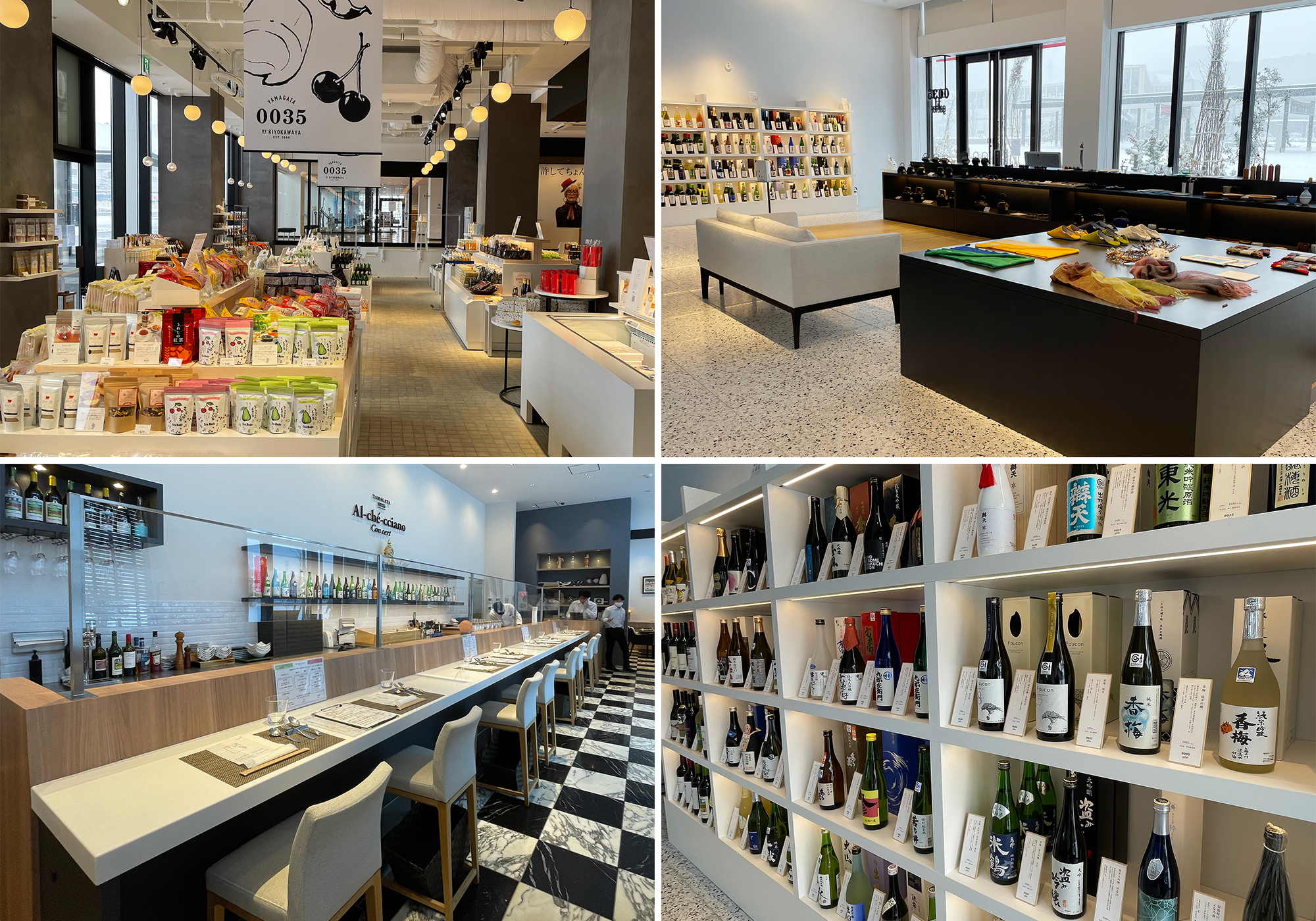
“When you think of Yamagata, you think of cherries, but the rice and sake are absolutely delicious too.”
For me, who was born outside the prefecture, my image of Yamagata Prefecture was like this.
However, after actually living here, I was surprised many times, saying, “There are so many wonderful things in Yamagata Prefecture!”
In fact, such place where you can discover the wonderful things of Yamagata Prefecture is in the immediate vicinity of Yamagata Station.
That is the Yamagata charm-transmission complex Yamagata 0035 KIYOKAWAWAYA.
Therefore, this time, not only for those who are coming to Yamagata for the first time, but also for those who live in the prefecture, there will be new discoveries at Yamagata 0035 KIYOKAWAYA that will be introduced in detail.
*Prices displayed are those at the time of the interview
Please note that details are subject to change.
1. Yamagata 0035 KIYOKAWAYA

When you get off the escalator heading from the west exit of Yamagata Station to the west exit station square, you will see the charm-transmission complex Yamagata 0035 KIYOKAWAYA.
It is next to the Yamagin Kenmin Hall (Yamagata Prefectural Cultural Arts Center) completed in 2020.
Here, you will find 0035 by KIYOKAWAWAYA, a shop selling prefectural products, 0035 gather, a select shop selling handicrafts and famous sake, and Al Ché-cciano Concert, an Italian restaurant that uses ingredients from Yamagata Prefecture.
“0035” in the store name is the number of all municipalities in Yamagata Prefecture, and it was named from the idea that “the 35 municipalities still have a lot of potential.”
00 seems to have a double meaning of ∞ (infinity)!
2. 0035 by KIYOKAWAYA

0035 by KIYOKAWAWAYA is located on the ground floor of the Yamagin Kenmin Hall. It is a shop selling a wide variety of products from Yamagata Prefecture including some that are perfect for souvenirs.
There is a café and a high-end bread specialty shop too.
・Yamagata product shop

There are various corners in the large store, but the selection is amazing!


The sweets section alone is like this.


This “Monaka Cookie NANJO da BE (Nanyo City)” is a strange sweet that combines monaka and cookies.

It seems that you can enjoy a new texture that combines the crunchy feeling of monaka and the crumbly cookie in your mouth.
There is also a corner for local seasonings.


There are so many dressings alone.

This “Yudo no Yamashio” is a favorite of our family.

This salt is made from hot springs instead of seawater, and it has a mellow flavor and is very delicious.
Also, since Yamagata Prefecture is known as the fruit kingdom, any food made with local fruit looks delicious!


There were lots of drinks, jams and jellies.

Jelly with whole cherries in it!


Eguchi-san of Kiyokawaya, who guided us this time, recommended this jam.

It seems that it is a jam that is so satisfying to eat that you will be surprised by the chunky texture of the fruit when you eat it.

In addition, there are also foods using Funagata town’s specialty mushrooms and Tsuruoka city’s dadacha beans.

And at the ramen corner that Yamagata citizens love so much, there are many bags of noodles lined up.


“tori-chuka” featured in “The World Unknown to Matsuko”
In addition, there is bag noodles of “Kotohirasou” which is open for a limited time in Tsuruoka City, which is very popular among the citizens of the prefecture.

There is also a retort corner for local Yamagata dishes such as imoni and curry using local products!
Of course there are also tama konnyaku (konjac balls).



There are many other food items lined up, so you can enjoy choosing souvenirs to your heart’s content.



In addition to food, there is also a corner for miscellaneous goods that can be used every day.
Self-care goods such as aroma oils, natural soaps, and cosmetics are also available.
There were familiar daily necessities that felt just right for petit gifts and rewards for yourself.

There were many miscellaneous goods that let you feel the rich nature of Yamagata.


*Prices displayed are those at the time of the interview
Please note that it is subject to change.
・Fluffy! High-end white bread specialty shop Yurushite Chonmage

Yurushite Chonmage in 0035 KIYOKAWAWAYA is a high-end bread specialty store.
It seems that the shop’s name was given in the sense that the owners were sorry that their bread was so delicious..

A lot of bread was lined up on this day too.
You can also purchase products such as rusks made from this bread and spreads that go well with the bread.

・Prefectural ingredients café

After looking around for souvenirs, take a break at the in-store café.
You can eat seasonal fruit smoothies and sweets made with local ingredients at the eat-in corner.

An eye-catching fruit sandwich.
All the sandwiches lined up in the showcase look delicious!

It seems that the fruits that are sandwiched will change depending on the season.

Left/Mandarin Orange Right/Fruit Mix
By the way, this sandwich is made with the Yurushite Chonmage bread that I introduced above.
And the new product introduced was the Tsuyahime rice scone.
It is said that it is a collaboration product with a bakery that is good at developing rice flour bread.


The rice flour from Tsuyahime rice and Haenuki rice produced in the prefecture is blended, and it seems that you can enjoy a moist texture and sweetness that is different from wheat scones.
I ordered the tori-chuka man, a ramen-taste steamed bun that was only available for a limited time and was the first in Japan.

Nikuman in ramen.
I often eat tori-chuka at home.

Uzumaki naruto is cute.

There are green onions and chashu in it, and it tastes like eating ramen even though it’s meat buns!

The noodles that taste like they’ve been soaked in ramen soup are specially made for this nikuman.
The meat buns were filled with plenty of ramen and the people’s love for ramen.

*Prices displayed are those at the time of the interview
Please note that it is subject to change.
Detailed information

-
0035 by KIYOKAWAYA
Hours
10:00~18:00
(café last order at 17:00)
Closed
* Closed during the winter season from January to February
Address
1-2-38 Futaba-cho, Yamagata City
☎ 023-676-8111
3. 0035 Gather

0035 Gather is in a separate building across from the prefectural hall. It is a product shop where a collection of handicrafts and sake collected from within the prefecture are for sale.
The sophisticated space will make your heart beat faster.

・Handicrafts that enrich your life
First, let’s start with the craft.

In Yamagata Prefecture, a wide variety of handicrafts have been made from the history of different cultures born in the four regions (Murayama / Mogami / Okitama / Shonai) and the materials nurtured from the rich natural environment since ancient times.
Inside the stylish store, there are many handicrafts collected under themes such as carving, weaving, knitting, dyeing, and firing.


From old-fashioned traditional crafts to stylish and pop things arranged in a modern way, there are all wonderful things!
The reason why there are so many colorful things may be that it is unique to the area where people are less likely to go out in the winter surrounded by snow.

I will introduce them right away.
Hidariuma (Tendo City)
.jpg)
Hidariuma made by Tendo City, which has been manufacturing shogi pieces since the Edo period, is a piece with the horse character written backwards.
It is considered to be a talisman for prosperous business, and is a lucky item given as a housewarming gift or to people who have just started a business.
● Gassan Japanese paper (Nishikawa)

Gassan Japanese paper is handmade Japanese paper that has been handed down from the Edo period with a history of 400 years.
The handmade texture and modern colors are eye-catching.
● ABE HOME SHOES (Kahoku Town)

Babouche from ABE HOME SHOES in Kahoku Town, which accounts for 40% of domestic slipper production.
At this company, which has been making footwear since the Taisho era, all products are hand-made by craftsmen.
● Wild grape basket bag (Oguni Town)

The wild vines that have survived the cold winters of Yamagata are strong and have been used in vine crafts since ancient times.
Basket bags made from wild grapes, which require many processing steps after they are harvested, are one of the folk crafts that have been handed down as daily work during the long winter.
● Yamagata Casting (Yamagata City)

Yamagata casting originated in the late Heian period when it was discovered that the sand of the Mamigasaki River flowing through Yamagata City and the nearby soil were suitable for casting molds.

Today, Yamagata Casting, which is used to create everything from handicrafts to industrial products, is said to be the most appealing part of its thin, delicate modeling, beautiful casting surface, and accuracy of dimensions and shape, and has been designated as a national traditional craft.
The large pot with a diameter of 6.5m used in Japan’s No. 1 Imonikai Festival is also made from Yamagata casting.


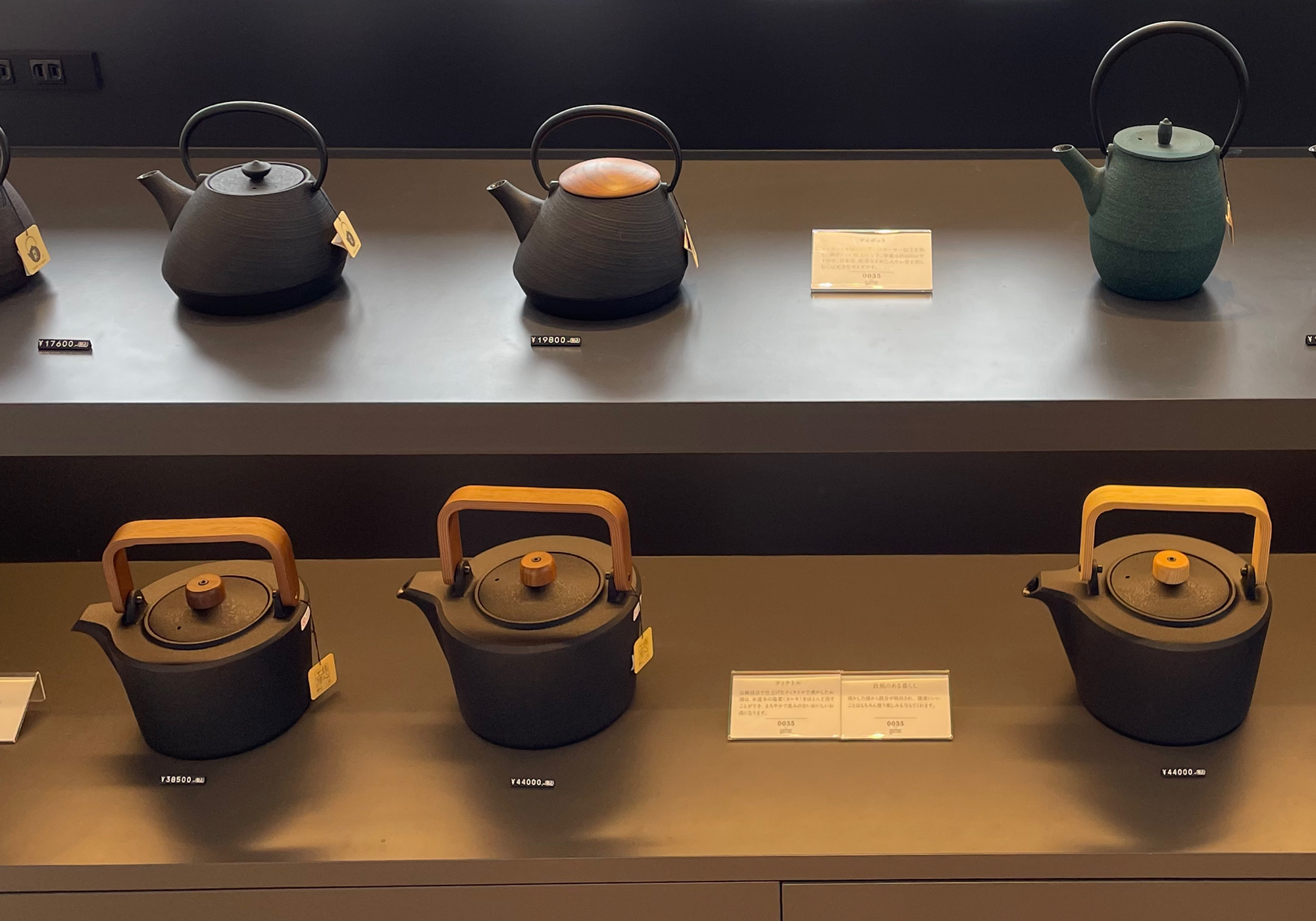
The modern design of the traditional kettle looks great in any style of kitchen.
Water surface flower stand (Nagai City)

This is a product made with casting technology that can be used as a vase or a small item holder.
It is said that the clear water surface of Nagai City, surrounded by mountains and flowing with many rivers, is a motif.
When using it as a vase, it seems that you can arrange flowers beautifully just by placing them on a glass.
It looks like it’s good to put soap and use it as a soap dish.
● Kibiso (Tsuruoka City)

Kibiso is a brand of new silk materials made in Tsuruoka City, one of Japan’s leading silk production areas.
Kibiso is the first thread that silkworms put out when they make cocoons, and it seems that it was not used as a fiber until now because it is thick and hard.

This brand has created new silk products using this millet, which has moisturizing, UV-absorbing and antioxidant properties.
● Uetsu Shinafu (Tsuruoka City)

Uetsu shinafu is made from shina, kozo, kudzu, and other plants that grow in mountainous areas.
The name Uetsu comes from Uzen (Yamagata Prefecture) and Echigo (Niigata Prefecture).
It is carefully made with time and effort using the techniques and techniques that have been handed down in the production area deep in the mountains.

Because it is durable and the texture does not change, it is said that it is sometimes used by two generations of parents and children.
● Yonezawa-ori (Yonezawa City)

Yonezawa-ori is one of Okitama Tsumugi, which is designated as a national traditional craft.
Known as a high-quality fabric, it is now used not only for Japanese clothing but also for western clothing.
There are many one-of-a-kind items woven using threads dyed using natural dyes.

● Shonai Sashiko (Sakata City)

Shonai Sashiko, which was born to survive the cold winter, is said to be one of Japan’s three major sashiko.
It is characterized by the large number of patterns and the fineness of the stitches.
● COOHEM (Yamabe Town)

Yamagata Prefecture is dotted with knit factories, and is a production area for knitwear that allows integrated production from thread making to dyeing, knitting, and sewing within the prefecture.
Enchanted by the impressive original knit tweed of the long-established knit manufacturer’s factory brand COOHEM.
● FUGA FUGA (Sagae City) 
Sato Seni’s brand FUGA FUGA develops and manufactures knit products, including original yarns and textiles that are attracting attention from the world’s top maisons.
The colorful socks seem to incorporate the original textile pattern.
● Sasano Ittobori Craftwork (Yonezawa City) 
● Yonezawa Carpet (Yonezawa City) 
Kenland Linen (Yamagata City) 
● Works by up-and-coming artists 
In addition to traditional crafts, there are also many works by young artists.






Come to 0035 gather where many handicrafts are gathered in one place, and please try to touch the wonderful things of Yamagata.
・A collection of famous sake that Yamagata Prefecture is proud of

Next, I would like to introduce the sake collection.
Sake selected from sake breweries and wineries are lined up on the racks on the wall, lined with famous sake.
There are rare brands of sake that are hard to come by due to the low distribution volume in the market.

Yamagata Prefecture has more than 50 sake breweries.
Many famous sakes are produced from the delicious rice that Yamagata is proud of and the famous water with different quality for each mountain range.

Yamagata Sanko is an original brand Junmai Daiginjo sake developed by the prefecture and the Prefectural Sake Brewers Association, aiming to be the best in Japan.

There are also many famous sakes that have won awards at sake fairs.

The sake Toko is brewed by Kojimaso Honten, a long-established brewery founded in the Azuchi-Momoyama period.
 Benten (Goto Sake Brewery/Takahata Town) Toko (Kojimaso main shop/Yonezawa City)
Benten (Goto Sake Brewery/Takahata Town) Toko (Kojimaso main shop/Yonezawa City)
Kosaka Sake Brewery brews sake that takes advantage of the cold weather of Yonezawa and is particular about cold brewing.
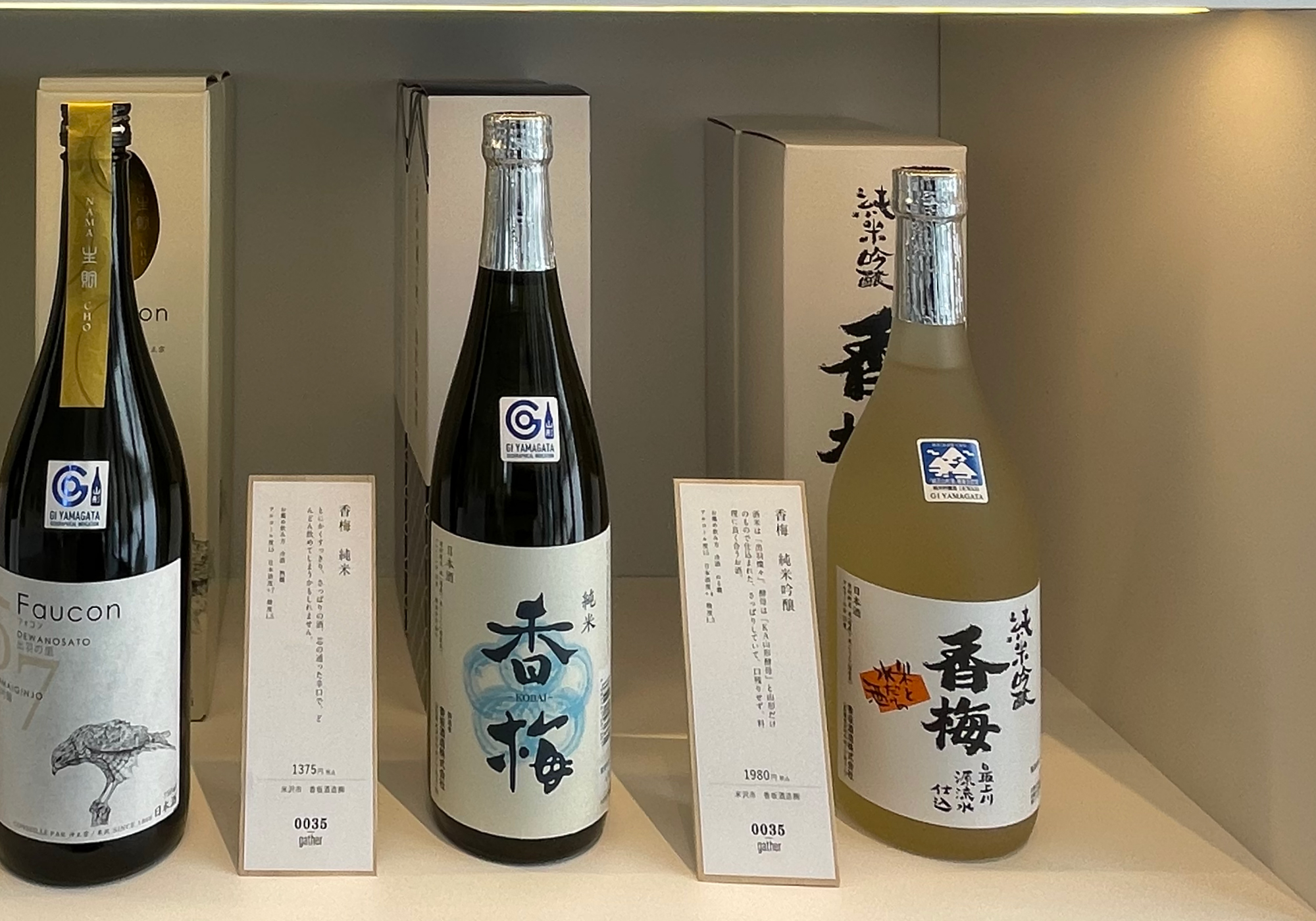 Kobai (Kousaka Sake Brewery/Yonezawa City)
Kobai (Kousaka Sake Brewery/Yonezawa City)
Some breweries, such as Shuho Sake Brewery, actively use Yamagata-grown rice and Yamagata-developed yeast.
 Shuho (Shuho Sake Brewery/Yamagata City)
Shuho (Shuho Sake Brewery/Yamagata City)
Asahigawa Sake Brewery uses underground water from Mt. Gassan, and more than 90% of the raw material rice is from Yamagata Prefecture.
The Asagi Bunsei 5-year series is produced exclusively by the female staff.
 Asagi Bunsei 5th Year (Asahigawa Sake Brewery/Kahoku Town)
Asagi Bunsei 5th Year (Asahigawa Sake Brewery/Kahoku Town)
Bellwood Vineyard, which started brewing at its own winery in the fall of 2020, is a winery that handles everything from cultivation to brewing.
 Bellwood Vineyard (Bellwood Vineyard/Kaminoyama City)
Bellwood Vineyard (Bellwood Vineyard/Kaminoyama City)
Yamagata, the kingdom of fruits, has a wide selection of fruit wines.

Also, from May 26, 2023, 0035 gather has started a paid tasting of local sake.
You can choose 2 brands from 4 to 8 brands of local sake (Japanese sake) and compare them.
Please try to drink and compare the local sake in Yamagata Prefecture!
*Prices displayed are those at the time of the interview
Please note that it is subject to change.
Detailed information

-
0035 gather
Hours
10:00~18:00Closed
* Closed during the winter season from January to February
Address
1-2-38 Futaba-cho, Yamagata City
·Message
We received messages from Eguchi-san of 0035 by KIYOKAWAWAYA and Okuyama-san of 0035 gather.
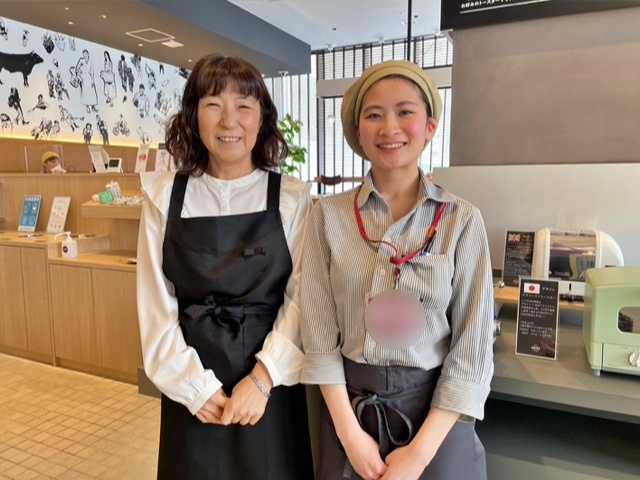 Left: Okuyama-san Right: Eguchi-san
Left: Okuyama-san Right: Eguchi-san
Eguchi: “When you come to Yamagata, please come to our store and experience the delicious things of Yamagata.”
Okuyama: “From the outside, it may seem a little intimidating, but it’s good to just look at it, so please feel free to come inside the store and try out some of Yamagata’s wonderful products. I can also recommend the sake that goes with it.”
4. YAMAGATA 0035 Al Ché-cciano Concert
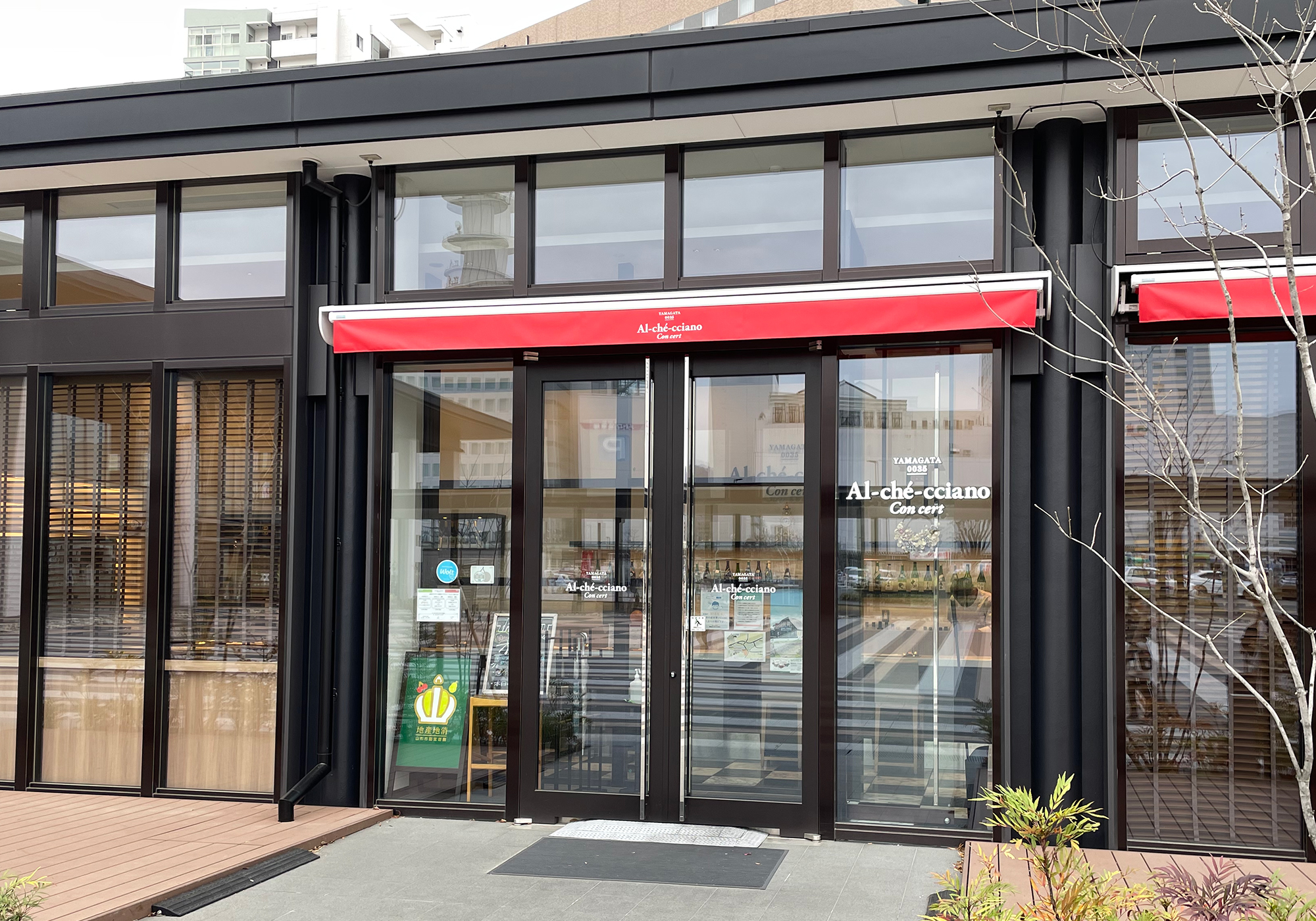
YAMAGATA 0035 Al Ché-cciano Concert is an Italian restaurant where you can enjoy the rich ingredients of Yamagata on the spot.
The owner chef is Mr. Masayuki Okuda of the Italian restaurant Al Ché-cciano in Tsuruoka City.
He is also active as a goodwill ambassador for Shonai, the capital of food.

At Al Ché-cciano Concert, they use plenty of ingredients not only from Shonai but from all over Yamagata Prefecture.
We asked Mr. Komatsu, the manager, about the appeal of Yamagata ingredients and the restaurant’s cuisine.

・The appeal of Yamagata ingredients
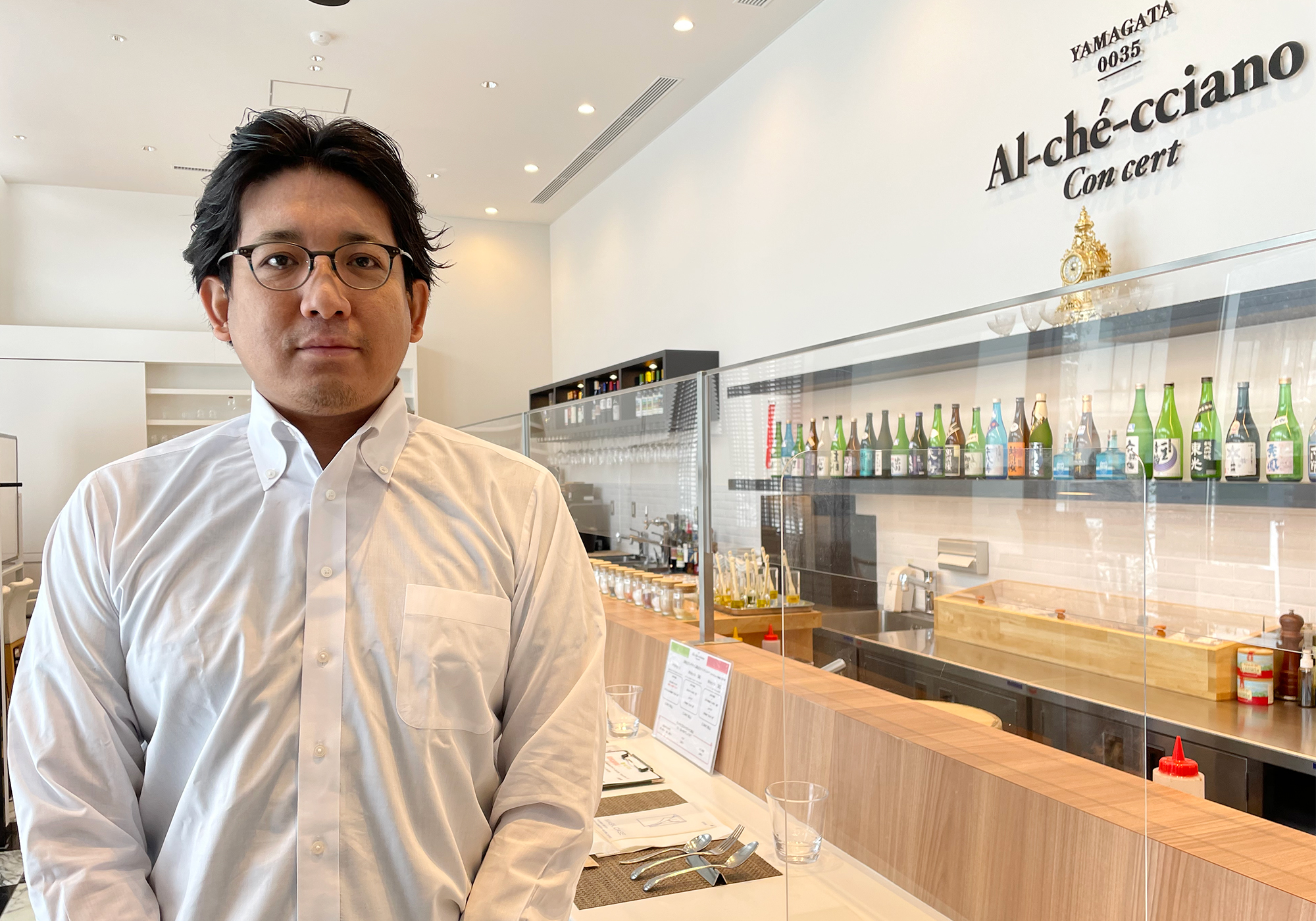
“There are a wide variety of vegetables grown in the rich soil of Yamagata. There are many varieties of turnips alone.” (Mr. Komatsu)
Surprisingly, it seems that there are more than 10 varieties of turnips alone.
Many vegetables are produced in Yamagata Prefecture because of its rich natural environment with diverse topography such as the sea and mountains, plains and basins surrounded by mountains, and seasonal temperature differences. This is due to its unique food culture.
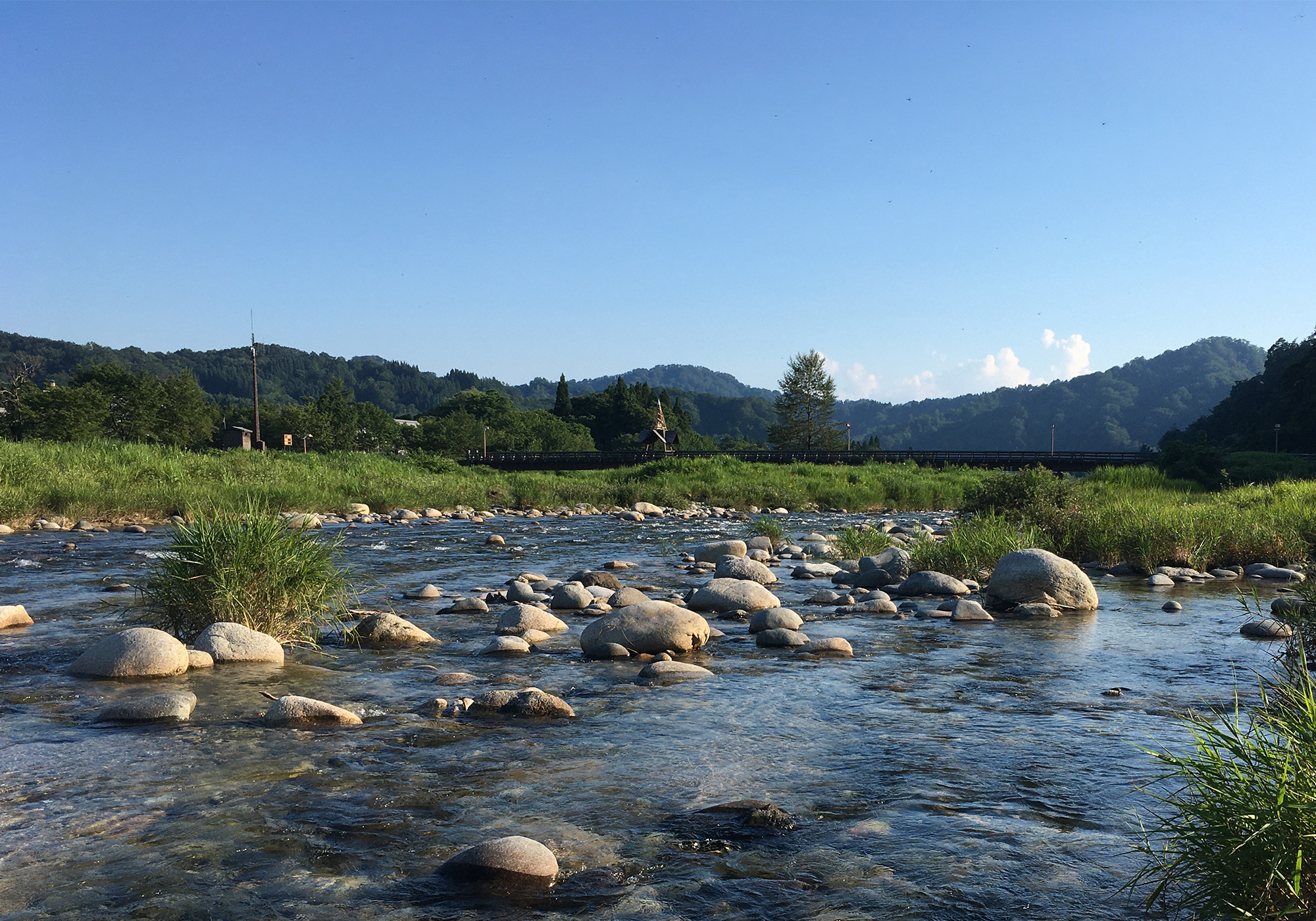
At Al Ché-cciano, which started in Tsuruoka City, the first city in Japan to be certified in the food culture category of the UNESCO Creative Cities Network, there is also a connection with the producer, and it is still difficult to obtain at this time. It seems that vegetables such as “native species” are used for cooking.
Indigenous species are unique vegetables that are cultivated only in the region, and a wide variety of ingredients nurtured by the rich natural environment resulting from the ocean currents of Yamagata Prefecture and the terrain with differences in elevation. It seems that many “indigenous crops” that have been inherited have been inherited.
In order to make the most of the ingredients produced in the prefecture, the restaurant doesn’t do elaborate dishes, and the important guideline when making recipes is how to convey the appeal of vegetables.

“For example, I’m thinking of combinations that take advantage of the strengths of each ingredient, such as roasting turnips, which have a high water content, and combining them with Shonai pork, or wrapping Yukina from Yonezawa in dry-cured ham,” says Komatsu.
It is said that there are times when the staff of the store actually grow “indigenous crops” by renting the fields of the producers.
Through the dishes served at the restaurant, he hopes that people will learn more about the appeal of ingredients unique to this place, including native crops that have been carefully handed down in the region.

“We recommend grilling the leaves and eating the stalks raw for Akane spinach, and we would like to propose that even the same vegetable can be enjoyed in different ways depending on the part.
Among the native species, there are many that even people living in the prefecture have never eaten.
For example, do you know “Makomo Dake”? ( Mr. Komatsu)
Only Makomo? What is it? mushrooms
“Makomodake is a plant of the rice family. It is delicious if you remove the skin from the stem and fry it in rice flour.” (Mr. Komatsu)
When serving food at a restaurant, he hopes to convey the charm of the ingredients by conveying information about the producers and the food.
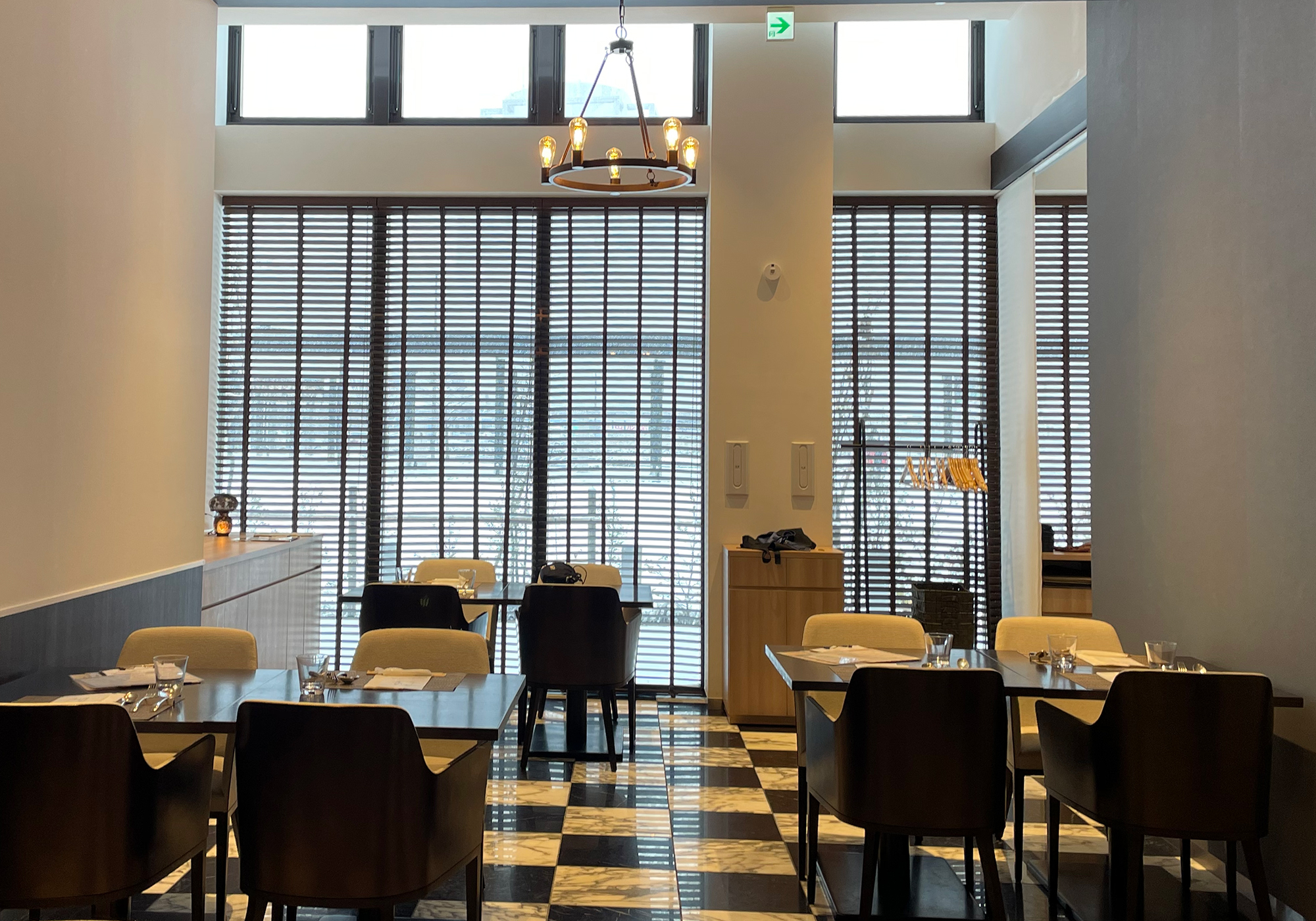
Al Ché-cciano Concert is the first branch to open in the inland area of Yamagata Prefecture, and we are making use of our connections with local producers not only in Shonai but also around Yamagata City to create new ingredients. It seems that they want to excavate.
“I want to be a place that connects producers and consumers.” (Mr. Komatsu)
Yamagata Prefecture has a high food self-sufficiency rate.
He said that he would like to become a base for disseminating the appeal of Yamagata food so that people will say that it is delicious.

Speaking of Al Ché-cciano, a famous dish is the oil sushi.
Oil sushi is sushi that is eaten with oil and salt instead of soy sauce, which was conceived by owner chef Okuda.
Shonai’s fishing port, where ocean currents intersect, is said to be rich in fish species.
To bring out the deliciousness of the fish and rice, he came up with the idea of using salt and oil, which are familiar seasonings around the world.
Please come and try the oil sushi that you eat with the best oil and salt for that fish.
Detailed information

-
YAMAGATA 0035 Al Ché-cciano Concert
Lunch time
11:30~15:00 (last order at 14:00)Dinner
17:00~21:00 (last order at 20:00)
Closed
Tuesday & 2nd and 4th Wednesday
5. In conclusion...
Finally, Mr. Sato of 0035 KIYOKAWAWAYA gave us a message to everyone reading VISIT YAMAGATA.
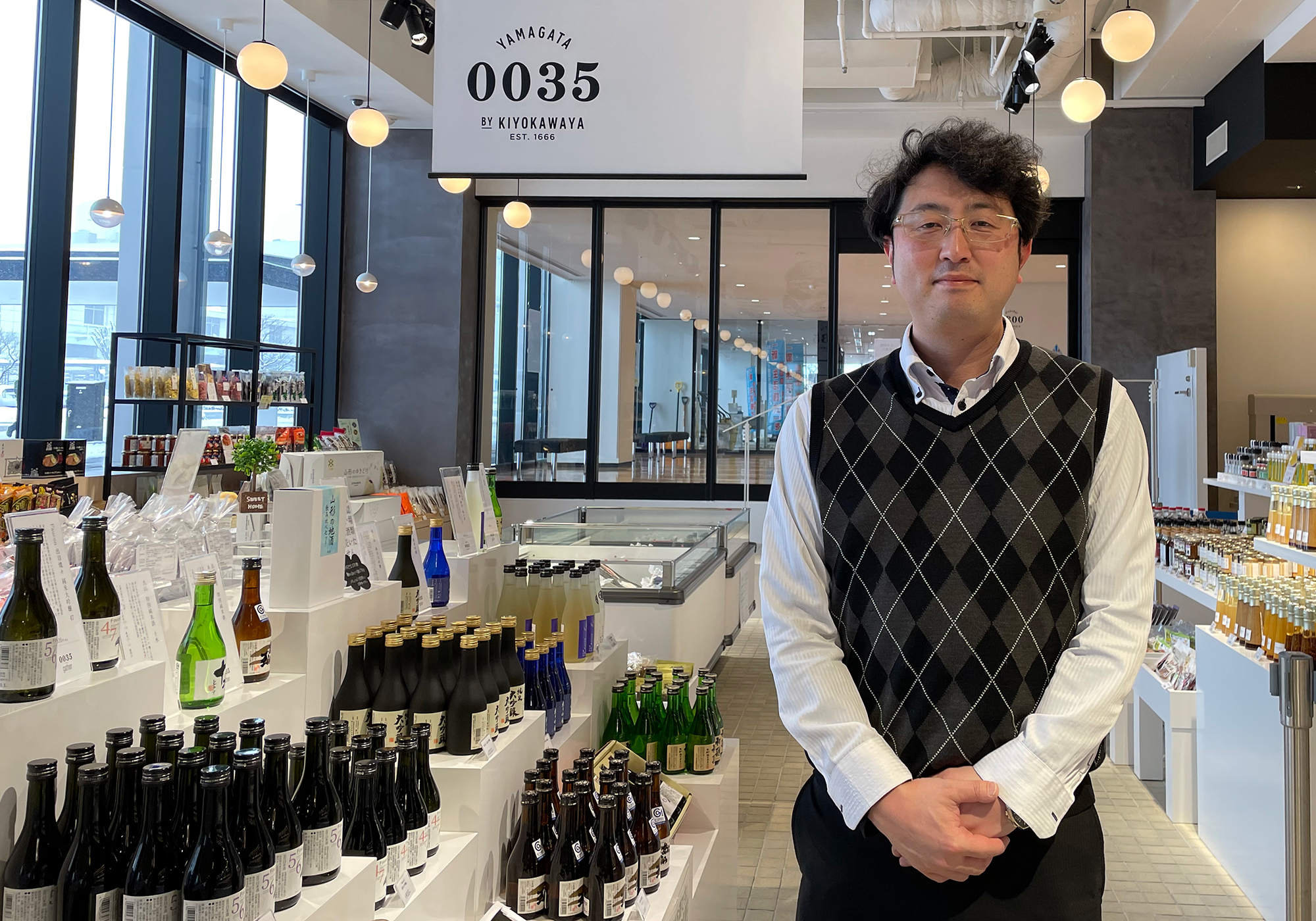
“Please stop by as a base where you can taste the good things of Yamagata in one place. There are many delicious dishes using ingredients that match the local characteristics, so I hope it will be a place where everyone who comes can discover a new Yamagata.”

![[Feature] Pino Collina Matsugaoka! Winery & Restaurant in Shonai](https://www.visityamagata.jp/wp/wp-content/uploads/2024/06/pinocollina.jpg)
![[Feature] Sahato Benihana! Enjoy the starry sky at the prefecture’s largest planetarium](https://www.visityamagata.jp/wp/wp-content/uploads/2024/07/sahato.jpg)
![[Summary] Safflower Festival 2024! Discover Yamagata’s prefectural flower](https://www.visityamagata.jp/wp/wp-content/uploads/2021/06/紅花①.jpg)
![[Feature] Miraini! Sakata Activity Hub](https://www.visityamagata.jp/wp/wp-content/uploads/2024/02/compile-image_1707742235039.png)
![[Feature] Yukotto! Refreshing time in hot springs](https://www.visityamagata.jp/wp/wp-content/uploads/2024/03/yukotto.jpg)